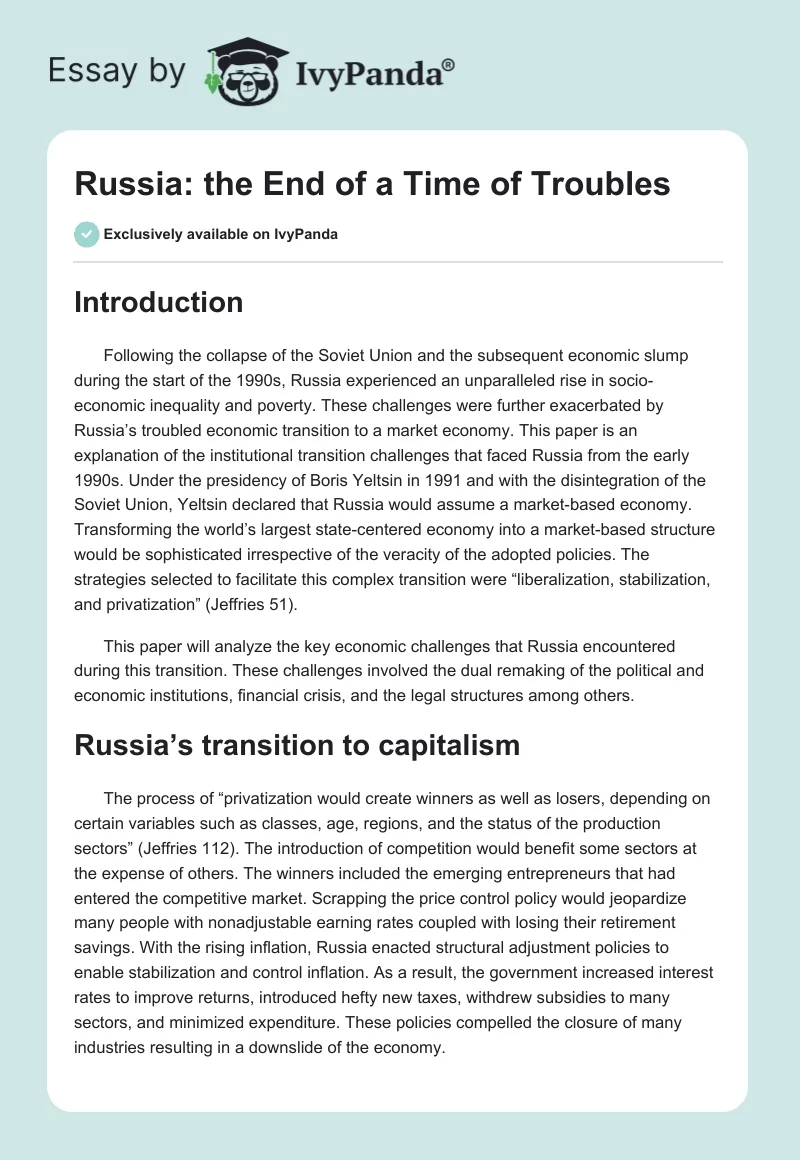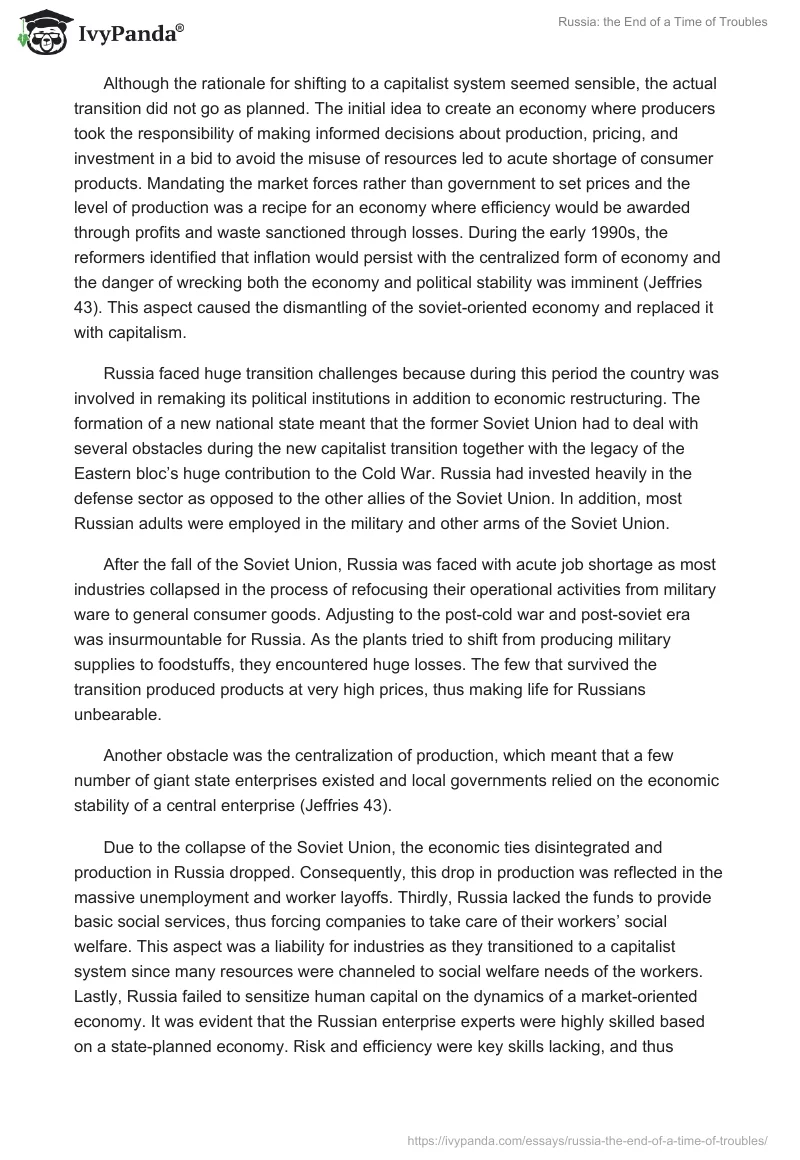Introduction
Following the collapse of the Soviet Union and the subsequent economic slump during the start of the 1990s, Russia experienced an unparalleled rise in socio-economic inequality and poverty. These challenges were further exacerbated by Russia’s troubled economic transition to a market economy. This paper is an explanation of the institutional transition challenges that faced Russia from the early 1990s. Under the presidency of Boris Yeltsin in 1991 and with the disintegration of the Soviet Union, Yeltsin declared that Russia would assume a market-based economy. Transforming the world’s largest state-centered economy into a market-based structure would be sophisticated irrespective of the veracity of the adopted policies. The strategies selected to facilitate this complex transition were “liberalization, stabilization, and privatization” (Jeffries 51).
This paper will analyze the key economic challenges that Russia encountered during this transition. These challenges involved the dual remaking of the political and economic institutions, financial crisis, and the legal structures among others.
Russia’s transition to capitalism
The process of “privatization would create winners as well as losers, depending on certain variables such as classes, age, regions, and the status of the production sectors” (Jeffries 112). The introduction of competition would benefit some sectors at the expense of others. The winners included the emerging entrepreneurs that had entered the competitive market. Scrapping the price control policy would jeopardize many people with nonadjustable earning rates coupled with losing their retirement savings. With the rising inflation, Russia enacted structural adjustment policies to enable stabilization and control inflation. As a result, the government increased interest rates to improve returns, introduced hefty new taxes, withdrew subsidies to many sectors, and minimized expenditure. These policies compelled the closure of many industries resulting in a downslide of the economy.
Although the rationale for shifting to a capitalist system seemed sensible, the actual transition did not go as planned. The initial idea to create an economy where producers took the responsibility of making informed decisions about production, pricing, and investment in a bid to avoid the misuse of resources led to acute shortage of consumer products. Mandating the market forces rather than government to set prices and the level of production was a recipe for an economy where efficiency would be awarded through profits and waste sanctioned through losses. During the early 1990s, the reformers identified that inflation would persist with the centralized form of economy and the danger of wrecking both the economy and political stability was imminent (Jeffries 43). This aspect caused the dismantling of the soviet-oriented economy and replaced it with capitalism.
Russia faced huge transition challenges because during this period the country was involved in remaking its political institutions in addition to economic restructuring. The formation of a new national state meant that the former Soviet Union had to deal with several obstacles during the new capitalist transition together with the legacy of the Eastern bloc’s huge contribution to the Cold War. Russia had invested heavily in the defense sector as opposed to the other allies of the Soviet Union. In addition, most Russian adults were employed in the military and other arms of the Soviet Union.
After the fall of the Soviet Union, Russia was faced with acute job shortage as most industries collapsed in the process of refocusing their operational activities from military ware to general consumer goods. Adjusting to the post-cold war and post-soviet era was insurmountable for Russia. As the plants tried to shift from producing military supplies to foodstuffs, they encountered huge losses. The few that survived the transition produced products at very high prices, thus making life for Russians unbearable.
Another obstacle was the centralization of production, which meant that a few number of giant state enterprises existed and local governments relied on the economic stability of a central enterprise (Jeffries 43).
Due to the collapse of the Soviet Union, the economic ties disintegrated and production in Russia dropped. Consequently, this drop in production was reflected in the massive unemployment and worker layoffs. Thirdly, Russia lacked the funds to provide basic social services, thus forcing companies to take care of their workers’ social welfare. This aspect was a liability for industries as they transitioned to a capitalist system since many resources were channeled to social welfare needs of the workers. Lastly, Russia failed to sensitize human capital on the dynamics of a market-oriented economy. It was evident that the Russian enterprise experts were highly skilled based on a state-planned economy. Risk and efficiency were key skills lacking, and thus Russian leaders lacked the requisite decision-making skills in the case of a capitalist economy (Perrie, Lieven, and Suny 33).
Who is to blame?
Reform was initiated by decree as opposed to consultations. In 1992, Yeltsin introduced the most critical segments of economic change by decree. While this move sparked heated debates, it prevented all efforts to engage in discussions that could come up with a desirable course of action for the economy. In a bid to curtail this radical reforms orchestrated by Yeltsin, the Central Bank, which was aligned to the conservative side, decided to slow the reforms by printing excess money intentionally during a period of depression. Consequently, economic instability exploded due to the rising effects of inflation. In the fall of 1993, Russia experienced constitutional crisis, which caused a political struggle between Yeltsin who was seeking radical privatization and the parliament who opposed privatization by decree. To some extent, the Yeltsin administration was to blame for the lack of the proper course to privatization. The rush to privatize created a loophole for misappropriation of public property by government officials who took advantage of their insider links (Bennett, Estrin, and Maw 816).
What is to be done
Despite the nearly financial collapse of the 1990s, the Russian economy can recover and stabilize as long as the government initiates shrewd economic policies. A major blow to the transition process is the government’s weakness in implementing its policies concerning taxing firms associated with people in political circles. Russia has to battle through its transition to capitalism since the reforms are now relatively irreversible and it appears that the severe setbacks have been overcome. Apparently, the economy of Russia remains prone to recession if, for example, world oil prices fall at a steady rate
Conclusion
Despite the backlash in the Russia’s transition to capitalism, there is still hope about a favorable economic environment under market structures. This study has shown that lack of extensive consultations about the right course of transition caused rifts that derailed the process. Nevertheless, if Russia can introduce effective transition laws, it will be in a position to make substantial progress in its bid to attain a capitalist system.
Works Cited
Bennett, John, Saul Estrin, and James Maw. “The choice of privatization method in a transition economy when insiders control a firm.” European Journal of Political Economy 23:3 (2007): 806-819. Print.
Jeffries, Ian. Economic developments in contemporary Russia, New York: Routledge, 2011. Print.
Perrie, Maureen, Dominic Lieven, and Ronald Suny. The Cambridge History of Russia, Cambridge: Cambridge UP, 2006. Print.


